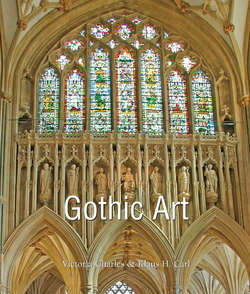Gothic Art

Реклама. ООО «ЛитРес», ИНН: 7719571260.
Оглавление
Victoria Charles. Gothic Art
Introduction
Gothic Architecture
The System of Gothic Architectural Art
Gothic Architectural Monuments
The Gothic in France
The Gothic in England
The Gothic in Germany and Austria
The Gothic in Italy
The Gothic in Belgium and the Netherlands
The Gothic in Scandinavia
The Gothic on the Iberian Peninsula
Gothic Painting
Gothic Painting in Germany
Gothic Painting in Belgium and the Netherlands
Gothic Painting in Italy
Gothic Painting in Spain
Illuminated Books
Gothic Frescos
Gothic Glass Painting
Gothic Sculpture
Gothic Sculpture in Italy
Gothic Sculpture in England
Gothic Sculpture in Germany
Gothic Sculpture in France
Gothic Sculpture in the Netherlands
Gothic Tomb Sculpture
Conclusion
Bibliography
Отрывок из книги
St. Eustache Hunts a Stag, detail from the Life of St. Eustache, Notre-Dame Cathedral, Chartres, c. 1200–1210. Stained-glass window.
Jan Van Eyck, St. Barbara, 1437. Silverpoint on paper,
.....
The changes that Gothic architecture brought to the ground plans of churches are less drastic and revolutionary. The basic form of the basilica was adopted from the previous Romanesque style and only expanded in some details. The cross-shaped ground plan was the norm; only the arms of the transepts did not always reach beyond the side walls of the nave. In the Late Gothic the transept was often discarded altogether. The nave was usually three aisled and even five aisled during the highest developmental stage of the Gothic. The best example is Cologne Cathedral (Illustrations 1, 2, 3).
The Gothic really only reinvented the formation of the choir. Since crypts were no longer built, the choir was no longer separated from the nave, but instead considered to be a continuation. The choir no longer ended in a half circle, but in a polygon. If the aisles led around the choir, they created an ambulatory. However, this was extended even further in the French Gothic: around the entire choir end, a series of chapels was added to the outer wall of the ambulatory. This chevet rendered the choir the most important part of the entire construction. The master builders of Cologne Cathedral also adopted such a chevet. When a new Gothic cathedral was built or a Romanesque one rebuilt, the first concern was usually the choir. The master builders and their clients invested most of their enthusiasm in it, not least because their main worry was housing the main altar as well as the local, often numerous clergy. Particularly in the initial, exuberant phase the funds provided by the princes of the Church flowed freely. Later, when these funds dried up, citizens were also forced to contribute. Consequently, the enthusiasm strongly diminished under the pressure of ecclesiastical or political turmoil. This explains why the choir structures often far surpass the naves in their richness of creation and artistic decoration. Also, the two sides of the nave are frequently uneven in design, one being more lavish, the other more sober and humble, which may be another indication of the decrease of overall wealth and artistic stamina. Very rarely did Gothic architectural works actually achieve complete balance, even though the law of symmetry was at the spiritual core of the style. The buildings that were completed in the nineteenth century came closest to this ideal.
.....